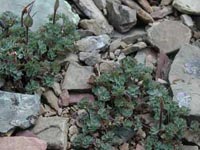Resource Library
Plant of the Week: Jones Columbine
The University of Arkansas System Division of Agriculture does not promote, support or recommend plants featured in "Plant of the Week." Please consult your local Extension office for plants suitable for your region.
Plant of the Week
Jones Columbine
Latin: Aquilegia jonesii

As the rest of our group of would be mountaineers looked at the Grinnell Glacier 2,000 feet below our feet, I was checking out the plant life on the narrow ridge of the continental divide in Glacier National Park. That's where I finally spotted it. The "it" was Jones columbine, a tiny cluster of blue-gray leaves about the size of a baby's fist.
Jones columbine (Aquilegia jonesii) is a plant of tremendous appeal amongst rock gardeners. I have read of it for years, and every year I request seeds from the rock garden seed exchange, but it's so highly prized and the seed is in such short supply, I've never received any. The excitement I felt on finding such a small, insignificant plant at 7,700 feet on a mountain pass in Montana is hard to explain.
Jones columbine is a high-altitude columbine confined to the gravely soils of the northern Rockies. In bloom, it produces a typical blue and white columbine flower with inch-long spurs. But each plant only produces a couple flowers on scapes that are held an inch or two above the small leaves. In flower, the plant would fit comfortably under the average-sized upturned coffee cup.
Discovery of the little plant gem was because our guide took us off-trail for a better view of the glacier. We worked our way across the steep face of the mountain on a loose talus slope of fractured rocks following a path the mountain goats favored. The official trail head was 200 feet lower down and devoid of the little columbine, but they were fairly numerous at the slightly higher overlook. The plants had flowered in July, and only the characteristic seed pods identified them as columbines.
The Grinnell Glacier should also share space with the little columbine for it's named after George Grinnell, the man largely responsible for establishing Glacier National Park. Grinnell first saw the glaciers in 1891 while writing an article for his sporting magazine Forest and Stream (now called Field and Stream) about the plight of the Blackfoot Indians of the area.
Grinnell spent his own money to finance a survey of the area and establish the boundaries of the million acre park. He was considered a mentor of the most famous of all environmentally conscious presidents, Teddy Roosevelt. In 1910, with the sponsorship of Montana congressman Charles Pray, Grinnell saw the area set aside as a National Park. In 1932, the Canadian government added another million acres of the Waterton Park, creating the International Peace Park.
Like all of the glaciers in the park, it's receding. Since 1850, it has lost 60 percent of its area. Park officials estimate that all of the glaciers could disappear by 2030 if they continue to shrink at their current rate.
Columbines are widely distributed plants in mountainous regions of the northern hemisphere. They do best in sunny, moist, but well drained sites. Most do best in calcareous soils. All, even the elusive Jones columbine, tend to be short lived and persist for two or three years before dying. But, if they find the site to their liking, columbines will reseed and establish a colony.
I know in my heart of hearts that Jones columbine is probably not going to like the heat and humidity of Arkansas. But, maybe this will be the year when I win the lottery and get a few seeds from the Rock Garden society. After all, gardeners are always optimistic.
By: Gerald Klingaman, retired
Extension Horticulturist - Ornamentals
Extension News - September 9, 2005
The University of Arkansas System Division of Agriculture does not maintain lists of retail outlets where these plants can be purchased. Please check your local nursery or other retail outlets to ask about the availability of these plants for your growing area.